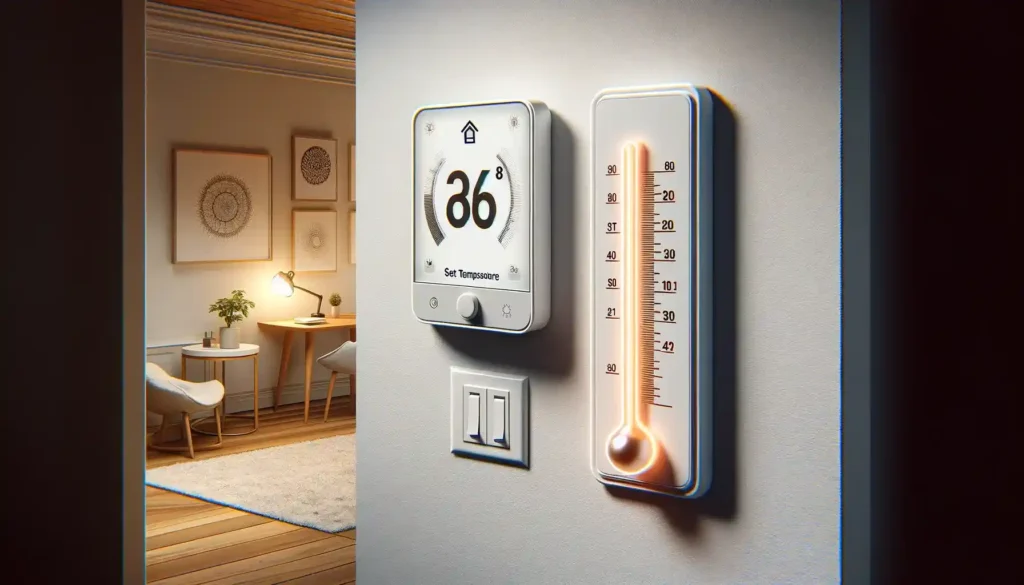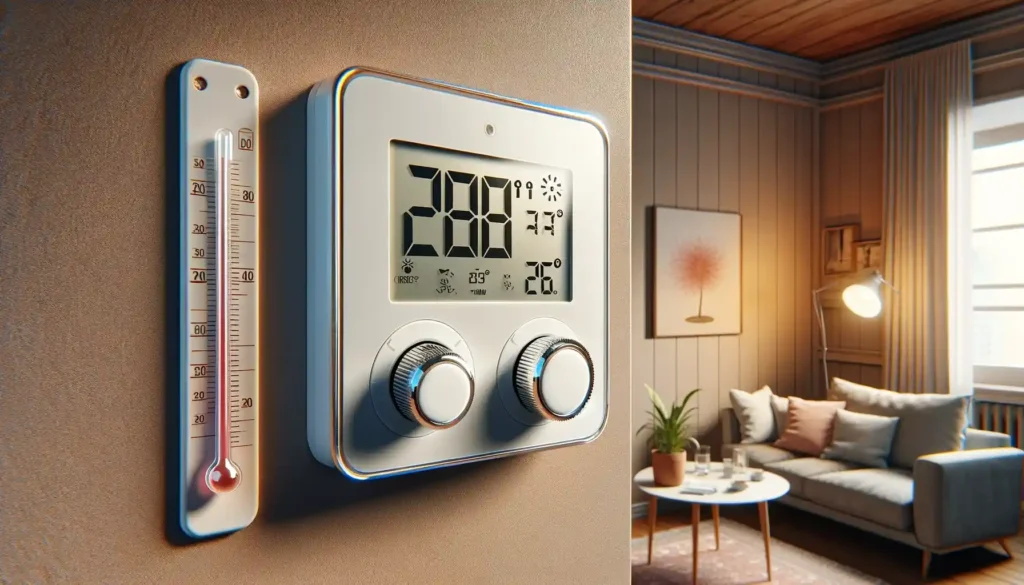If your room temperature doesn’t match the thermostat setting, it could be due to improper calibration, a dirty thermostat, or a malfunctioning HVAC system. This issue can lead to discomfort, energy inefficiency, and increased utility bills.
Understanding the potential causes and addressing them promptly can help create a comfortable and cost-effective indoor environment.
When your thermostat setting doesn’t align with the actual room temperature, several factors may be at play. We’ll explore common reasons for this discrepancy and offer practical tips to troubleshoot and resolve the issue.
By identifying the root cause and taking appropriate actions, you can ensure that your thermostat accurately reflects and maintains the desired indoor temperature.
You May Like
- 5-2 DAY PROGRAMMING: Separate programs for the weekdays and weekends with 4…
- PRECISE TEMPERATURE CONTROL: Precise temperature control of plus/- 1 degree…
- DIGITAL DISPLAY: The display panel is backlit with an intuitive interface…
- EASY INSTALLATION: Easy to install yourself and works with many…
- The RTH6360D offers flexible 5-2-Day or 1-Week programming so you can set…
- Backlit LCD display shows current room temperature and set point…
- Smart Response Technology learns how long it takes to achieve the right…
- Features auto changeover between heat and cool and reminder alerts for low…
- 【Notice】Please make sure to read the installation and wiring…
- 【Thermostat Applications】for with Conventional Single-Stage Heating…
- 【Incompatible Systems】Does not work multistage systems (1H/2C, 2H/2C),…
- Suuwer S701 Single Stage Non-Programmable Digital Thermostats for Home 1…
- Compatible with: Alexa, SmartThings, Google Home, IFTTT.Central Air…
- Check to see If your new thermostat qualifies for a utility rebate;…
- Customizable touchscreen in full Color with easy to read numbers and text,…
- Flexible programming options available based your home or small business…
Understanding The Room Temperature Discrepancy

Perceived Vs. Actual Room Temperature
One of the common issues homeowners face is the perceived room temperature not matching the thermostat setting. This discrepancy can cause discomfort and lead to higher energy bills.
The perceived room temperature is the one felt by individuals in the space, while the actual room temperature is the true temperature as measured by a thermometer.
Identifying The Discrepancy
The disparity between perceived and actual room temperature can be attributed to various factors, including poor insulation, drafty windows, heat sources, and thermostat accuracy. Identifying these factors is crucial for resolving the discrepancy and creating a comfortable living environment.
Common Reasons For Temperature Mismatch
Improperly Located Thermostat
One of the common reasons for temperature mismatch in your room could be an improperly located thermostat. If the thermostat is placed near a heat source or direct sunlight, it may give inaccurate readings, leading to temperature inconsistencies.
Inaccurate Thermostat Reading
An inaccurate thermostat reading can also be a reason for room temperature not matching the thermostat setting. This can happen due to dust or debris accumulation in the thermostat unit, causing it to malfunction and display inaccurate temperature readings.
Hvac System Issues
Problems within your HVAC system, such as a malfunctioning thermostat sensor, dirty filters, or issues with the ductwork, can also lead to temperature discrepancies in your room. It’s essential to regularly maintain and service your HVAC system to avoid such issues.
Troubleshooting The Thermostat

Troubleshooting the thermostat is essential when your room temperature doesn’t match the thermostat setting. Issues with the thermostat can lead to uncomfortable indoor temperatures and higher energy bills.
To get to the bottom of the problem, it’s crucial to check the battery and connections, as well as calibrate the thermostat:
Checking Battery And Connection
If your thermostat is battery-powered, a low battery can cause temperature discrepancies. It’s important to check the battery regularly and replace it as needed.
Additionally, ensure that the thermostat is securely connected to the HVAC system. Loose or faulty connections can lead to malfunctions.
Inspect the wiring and terminals to make sure everything is secure and free from corrosion. Addressing any issues with the battery and connections can help resolve temperature disparities.
Calibrating The Thermostat
Calibrating the thermostat can help ensure accurate temperature readings and better performance. Refer to the manufacturer’s instructions to recalibrate the thermostat properly.
This may involve adjusting the anticipator, if applicable, or making minor setting changes. By calibrating the thermostat, you can fine-tune its accuracy and improve its ability to maintain the desired indoor temperature.
Checking Hvac System

When troubleshooting a thermostat that doesn’t match room temperature, it’s crucial to start by checking the HVAC system. This step allows you to inspect various components such as the air filter and ductwork, which can directly impact the thermostat’s accuracy.
By conducting a thorough examination, you can identify potential issues and take the necessary steps to rectify the problem.
Air Filter Inspection
One of the primary factors affecting the functionality of an HVAC system is the condition of the air filter. A clogged or dirty air filter can obstruct airflow, leading to inconsistent temperature distribution throughout the home.
Therefore, it’s essential to regularly inspect and replace the air filter as recommended by the manufacturer.
Ductwork Examination
The ductwork plays a critical role in distributing conditioned air throughout the property. Any leaks, blockages, or damage within the ducts can result in inefficient airflow and temperature disparities.
Conduct a thorough examination of the ductwork to identify any issues that may be affecting the HVAC system’s performance.
Professional Assistance And Further Considerations
When it comes to maintaining a comfortable indoor environment, ensuring that the room temperature aligns with the thermostat setting is crucial.
However, there are instances where the room temperature doesn’t match the thermostat setting, leaving you feeling uncomfortable and frustrated.
In such situations, seeking professional assistance and considering various factors to pinpoint the issue becomes imperative.
Hvac Technician Consultation
If you find that the room temperature consistently deviates from the thermostat setting, it’s advisable to enlist the expertise of a qualified HVAC technician.
Professional technicians possess the knowledge and skills to accurately diagnose and rectify issues related to heating, ventilation, and air conditioning systems.
By conducting a thorough inspection, they can identify and address any underlying mechanical or electrical problems affecting the temperature regulation within your home.
Variable Factors Impacting Room Temperature
Understanding the diverse factors that can impact room temperature is crucial in addressing discrepancies between the thermostat setting and the actual conditions.
Factors such as drafts, inadequate insulation, and obstructed air vents can significantly affect the temperature consistency within your home.
By considering these variables, you can take proactive measures to optimize your HVAC system and enhance overall climate control efficiency.
Frequently Asked Questions For Room Temperature Doesnt Match Thermostat Setting
Why Is My Room Temperature Different From The Thermostat Setting?
The room temperature may vary due to factors like insulation, sunlight, and air circulation.
How Can I Make My Room Temperature Match The Thermostat Setting?
Check for drafts, use curtains to block sunlight, and ensure proper calibration of the thermostat.
What Role Does Humidity Play In Room Temperature Regulation?
Humidity affects how the body perceives temperature. Proper ventilation and dehumidifiers can help.
Conclusion
Inaccurate room temperature can cause discomfort and energy wastage. To solve this issue, consider performing regular thermostat maintenance and using smart technology like programmable thermostats.
Keep your HVAC system in top condition to ensure efficient temperature regulation. By taking these steps, you can enjoy a comfortable and cost-effective indoor environment all year round.





